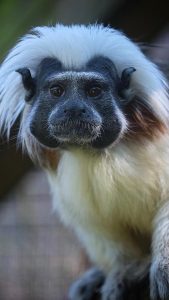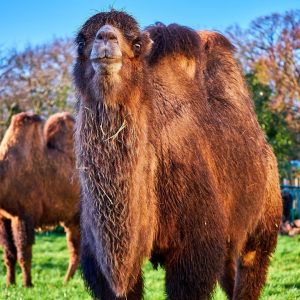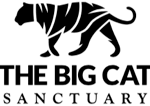Here at Paradise Wildlife Park, we are home to a range of vulnerable to even critically endangered animals. As a wildlife charity, we believe that our role is to protect these endangered species and help educate our guests about them. This is all in an effort to spark affiliation between visitor and animal. When this happens, people are far more likely to be receptive to the challenges wild species face. As a result, we are able to form a united front to help protect our planet’s wildlife.
The International Union for Conservation of Nature is a governing body that categorises what species are vulnerable, threatened, endangered, critically endangered and extinct. Wild Bactrian Camels are categorised as critically endangered, and our Cotton Topped Tamarins are classed as critically endangered.
Our troop of Cotton-Top Tamarins are found in the Rainforest Building and are a lively bunch of inquisitive primates. We are home to a fantastic troop made up of Dolph, Maxi and Clara. Mo and Navas, our Bactrian Camels are found at the very centre of Paradise, keeping a watchful eye on the comings and goings of the park. They are stepbrothers and can be boisterous with each other. What brothers aren’t?
To bring about some awareness for both endangered species, we have collated our favourite facts!

Cotton-Top Tamarins:
- Cotton-Top Tamarins form social family groups that include breeding parents, their adult offspring, and even unrelated adults who have migrated to the group.
- Cotton-Top tamarins are named for the shock of white hair encircling their heads, a look reminiscent of Albert Einstein.
- They have claw-like nails, which are critical to jumping from tree to tree in their forest habitat.
- Cotton-Top Tamarins live in a small forested area of north-western Colombia.
- Today, deforestation and human activity pose the most significant threats to the survival of Cotton-Top Tamarins.

Mo and Navas, Bactrian Camels:
- Bactrian Camels are native to the Gobi Desert in China and the steppes of Mongolia.
- Bactrian Camels grow a shaggy coat in the winter for protection from the freezing cold and shed the coat during the hot summer. As they can survive a wide range of temperatures, from -29°C to 49°C.
- There are currently about 650 Bactrian camels in China and about 450 in Mongolia. The Wild Camel Protection Foundation was established in 1997 and has set up a natural reserve in China for Bactrian camels.
- Bactrians’ nostrils close to keep sand at bay, and their bushy eyebrows and two rows of long eyelashes protect their eyes from sandstorms.
- Their big, flat footpads help them navigate the rough, rocky terrain and shifting desert sands without sinking under their own weight.
We hope that you have learnt something new on Endangered Species Day! The sad reality is that these species in the wild are declining and at risk of extinction. If the worst case scenario occurs where we lose all wild Bactrian Camels and Cotton-Top Tamarins, zoos will have individuals that could be reintroduced to the wild. This is why your support is so important. By visiting the park, adopting an animal, booking an experience, becoming a member or donating to our charity, you are helping us continue our conservation efforts through our resident animals and across the world. In the last 20 years, we have donated £5 million to wildlife conservation organisations across the globe, and we could not have done this without your support.
Thank-you from all the teams and animals at Paradise Wildlife Park.





